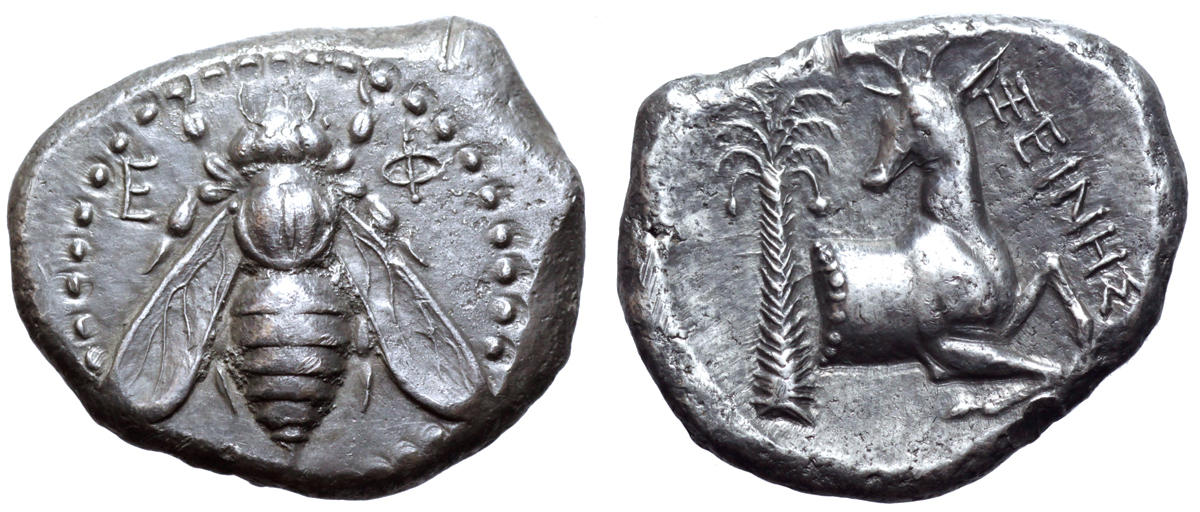S 1962 - Ephesus, silver, didrachms (395-385 BCE) Kinns
From SILVER
395 BCE - 385 BCE Silver 1,057 kg
Description
| ObverseInscription or printing placed on the obverse.: | Ε-Φ flanking (Greek).Xeines, magistrate. Bee with slightly curved wings seen from above |
| ReverseInscription or printing placed on the reverse.: | ΞΕΙΝΗΣ downward to right (Greek).Forepart of stag to right with head reverted, palm tree to left |
Mint and issuing power
| MintIdentifies the place of manufacture or issue of a numismatic object.: | Ephesus | Ancient regionAncient region.: | Ionia | Modern countryModern country: Turkey | AuthorityIdentifies the issuing power. The authority can be "pretended" when the name or the portrait of X is on the coin but he/she was not the issuing power. It can also be "uncertain" when there is no mention of X on the coin but he/she was the issuing power according to the historical sources: |
Chronology
| FromIdentifies the initial date in a range assigned in a numismatic context. | 395 BCE | toIdentifies the final date in a range assigned in a numismatic context.. | 385 BCE | PeriodTime period of the numismatic object.: Classical 480-323 BC |
Physical description
| MetalThe physical material (usually metal) from which an object is made.: | Silver |
Median weightMedian of the weights of numismatic objects (in grams). in grams | 7.40 | DenominationTerm indicating the value of a numismatic object. Examples: tetradrachm, chalkous, denarius.: | didrachm |
StandardStandard.: | Chian |
Image

S1962 Ephesus didrachms.jpg [1]
References
| Die study referencePublication of the study: | Ashton - Kinns - Konuk - Meadows 20021Ashton - Kinns - Konuk - Meadows 2002, p. 102 | ||
| Coin series referenceReference to coin series study: | |||
Obverse dies distribution
| FrequencyFrequency of specimen in distribution. ᵖ | Number of obversesNumber of obverse dies. ᵖ (o) | % (o) | Number of coinsNumber of coins. (n) | % (n) | Die nameName(s) of the die(s). |
| 1 | 2 | 40 | 2 | 16.67 | 2, 5 |
| 3 | 2 | 40 | 6 | 50 | 3, 4 |
| 4 | 1 | 20 | 4 | 33.33 | 1 |
| Total | 5 of 5 | 100 | 12 of 12 | 100 |
Reverse dies distribution
no distribution is available
Quantification
| Number of obversesNumber of obverse dies. ᵖ (o) | 5 | Number of singletons (o1)The number of singleton coins. ᵖ | 2 |
| Number of reverse diesNumber of reverse dies. (r) | 6 | Number of coinsNumber of coins. (n) | 12 |
| Coins per obverse dieNumber of coins per obverse die. (n/o) | 2.4 | Coins per reverse dieNumber of coins per reverse die. (n/r) | 2 |
| Reverse per obverse ratioRatio of obverse dies divided by reverse dies. (r/o) | 1.2 | Percentage of singletons (o1)number of coins (n) divided by the number of singletons (o1) ᵖ | 40 % |
| Original number of dies (O) (Carter 1983 formula)The estimation of the number of coins according to Carter 1983 ᵖ | 7.14 | Coins struck if 20,000 as average productivity per dieCoins made if the average productivity for obverses (according to Carter) is 20,000. ᵖ | 142,800 |
| Original number of dies (O) (Esty 2011 formula)The estimation of the number of coins according to the singleton formula in Esty 2011 ᵖ (O) | 8.57 | Survival rate if 20,000 as average productivity per dieSurvival rate if average productivity is 20,000. ᵖ | 0.00008 |
| Coverage (o = % of O) (Esty 1984 formula)Esty 1984 - coverage (% of O) ᵖ (o = % of O) | 83.33% | Die productivity if survival rate 1/2,000Average productivity if survival rate is 1/2,000. ᵖ | 3,361.34 |
| Weight of silver (in kg) if 20,000 coins per die (O = Carter formula)Carter 1983 * Median weight * 20000 (*10 if gold or electrum) ᵖ | 1,057 kg <br /> 1,057 kg | Die productivity if survival rate 1/5,000Average productivity if survival rate is 1/5,000. ᵖ | 8,403.36 |
Remarks
Most likely one single workstation
References
- ^ Ashton, Richard - Kinns, Philip - Konuk, Koray - Meadows, Andrew (2002), "The Hecatomnus Hoard (CH 5.17, 8.96, 9.387)", Coin Hoards, IX, London, p. 95-158